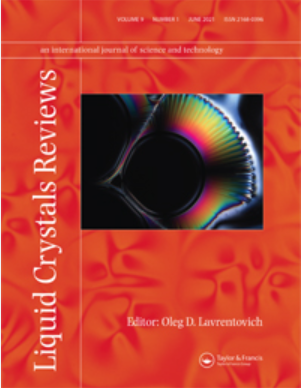Liquid crystal polymer networks: switchable surface topographies
IF 4.2
3区 材料科学
Q2 CHEMISTRY, PHYSICAL
引用次数: 44
Abstract
Coating of liquid crystal (LC) networks modified with azobenzene moieties as crosslinks was reviewed to create surface topographies in the micrometer range by exposure with UV light. Various configurations were worked out. Homogeneous cholesteric networks and homeotropic nematic networks could form well-defined protrusions by local exposure. The protrusions can be dynamic, i.e. disappear as soon as light is switched off, or be permanent keeping stable topological structures even after the exposure stops. The formation of the protrusions was proven to be induced mainly by a decrease in density when the order in the LC network is reduced under the trans to–cis isomerization of the azobenzene units. Next to the photochemical effect also heating by absorption played a role. When the polymer network coating was build up from alternating cholesteric and homeotropic areas a uniform exposure led to the surface topography. When exposed, the cholesteric areas are protruding and the homeotropic areas are indenting. In this the deformation is enhanced by the orchestrated linear geometric shear deformations in the neighboring areas where the homeotropic areas tend to expand in the lateral direction and the cholesteric areas in the direction perpendicular to the coating.液晶聚合物网络:可切换的表面形貌
研究了以偶氮苯基团作为交联修饰的液晶(LC)网络涂层在紫外光照射下形成微米范围内的表面形貌。设计了各种配置。均质胆甾网络和同向异性向列网络可通过局部暴露形成明确的突起。这些突出物可以是动态的,即一旦关闭光线就会消失,也可以是永久性的,即使在曝光停止后也能保持稳定的拓扑结构。在偶氮苯的反式-顺式异构化过程中,LC网络的有序度降低,从而导致了分子密度的降低。除了光化学效应外,吸收加热也起了作用。当聚合物网络涂层由交替的胆甾和各向同性区域建立时,均匀的暴露导致表面形貌。暴露时,胆甾区突出,各向同性区凹陷。在这种情况下,变形被相邻区域的有序线性几何剪切变形增强,其中各向同性区域倾向于在横向方向上扩展,胆甾区倾向于在垂直于涂层的方向上扩展。
本文章由计算机程序翻译,如有差异,请以英文原文为准。
求助全文
约1分钟内获得全文
求助全文
来源期刊

Liquid Crystals Reviews
CHEMISTRY, PHYSICALCRYSTALLOGRAPHY&n-CRYSTALLOGRAPHY
CiteScore
7.60
自引率
5.90%
发文量
8
期刊介绍:
Liquid Crystals Reviews publishes review articles on all aspects of liquid crystal fundamentals and applied science, including experimental and theoretical studies of physical and chemical properties, molecular design and synthesis and engineering of liquid crystal devices. The Journal fosters cross-disciplinary exchange of ideas, encouraging authors to present material at a level accessible to specialists from other fields of science and engineering. Liquid Crystals Reviews provides the scientific community, in both academia and industry, with a publication of standing, guaranteed by the Editors and by the International Editorial Board who are active scientists in the worldwide liquid crystal community.
 求助内容:
求助内容: 应助结果提醒方式:
应助结果提醒方式:


